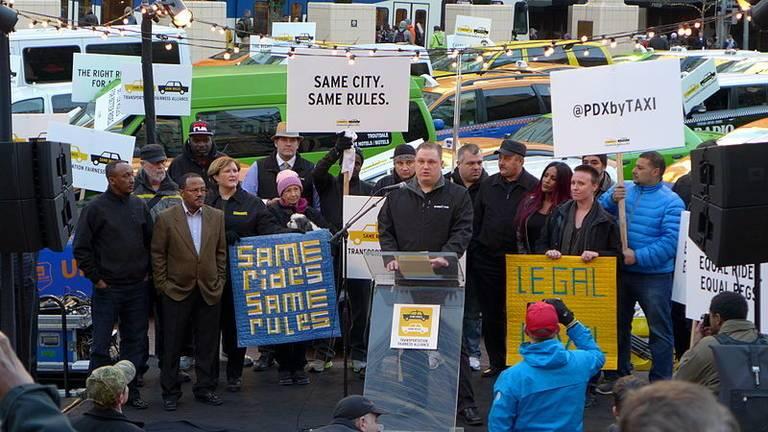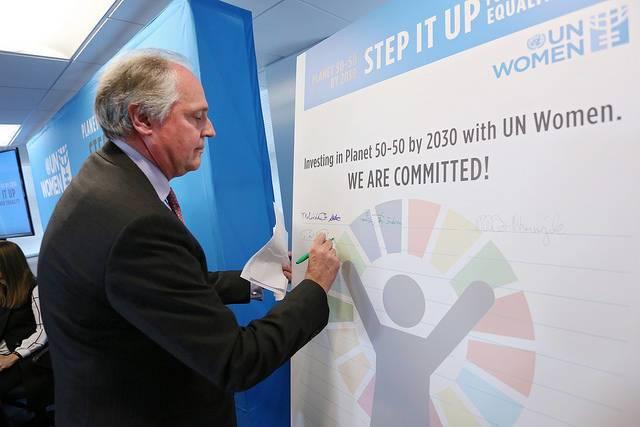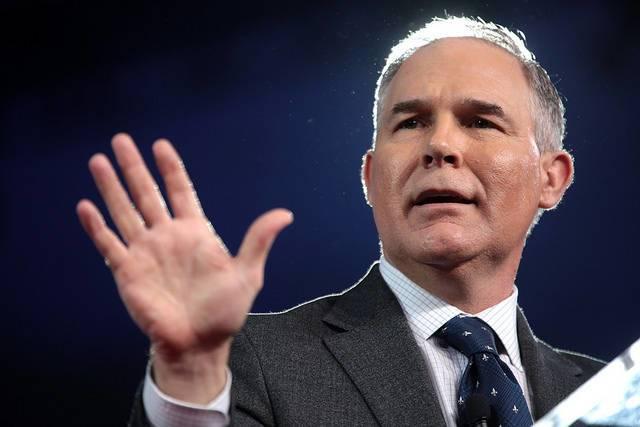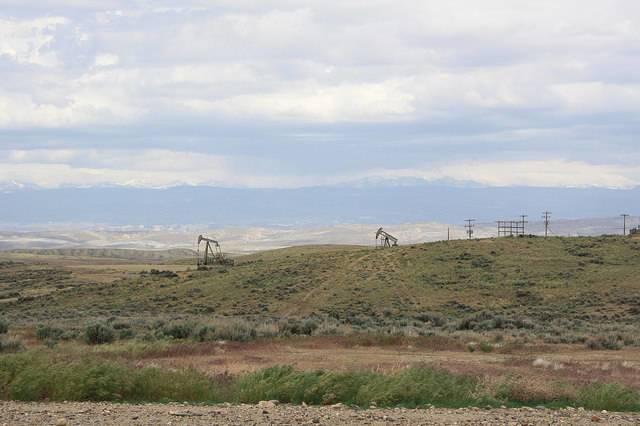The Vegan ‘Bloody Burger’ May Soon Roll Out Nationwide


Hamburgers have roared in popularity over the past decade, and everyone has their favorite local joint or cult-like affinity for chains such as In-N-Out Burger and Shake Shack. But those cravings are also matched by an increasing concern over the meat industry’s impact, from those occasional foodborne illness outbreaks to deforestation.
Meanwhile, plant-based meat alternatives like Beyond Meat, Gardein and Yves are improving in taste and quality. Another fake meat company, Impossible Foods, hit the headlines in 2014 with its vegan 'bloody burger' made from coconut oil, wheat and potato protein. The burger appears red when raw and browns when cooked, just like the real thing. And it comes with a side of heme, a ferrous molecule that gives beef that meaty taste many of us crave.
Last year, the Impossible Burger made its debut at a Momofuku restaurant location in New York City. Since then, the burger made it onto menus at NYC’s Public and Saxon + Parole, as well as some high-end restaurants in California.
Last week, Impossible Foods scored a relationship with its first national burger chain at what is for now the small but popular eatery Bareburger. As Mic reported last week, the alternative burger will be offered not on a vegetarian menu, but alongside burgers made from elk, bison and beef.
So can this plant-based delicacy, which Mic’s Alex Orlov described as the “$80 million veggie burger [that] could help fight climate change,” sway meat lovers away from cows?
Impossible Foods’ founder, Stanford University biochemistry professor Pat Brown, says the company is on course to give meat-lovers a product that will eventually be as affordable as beef, but without wreaking havoc on the planet’s environment.
Many NGOs have long insisted that the global meat industry, especially the beef sector, is the world’s largest contributor to deforestation. In contrast, Impossible Foods claims its product requires 95 percent less land, consumes 74 percent less water and emits 87 percent fewer greenhouse gas emissions than beef burgers.
With a White House that is now dismissive of climate change risks and appears determined to dismantle the Environmental Protection Agency, the reality is that it will be up to the market to reduce emissions. As reported in publications including Forbes, Impossible Foods does not consider its competitors to be the likes of vegan food companies Quorn or Morningstar. Instead, Impossible Foods strives to be on the menu alongside meat options such as beef and lamb.
The trick is to offer more than a substitute for meat: To be successful, animal-free products have to taste just as good as the “real thing,” or even better. Beyond Meat, for example, strives to bring the price of its fake chicken strips -- made from ingredients including carrot fiber and pea flower -- down to the same as chicken breast meat, or even cheaper if possible.
The Impossible Burger is now on the menu at Bareburger's flagship restaurant near New York University. It will appear at other Manhattan locations this month and will eventually roll out at Barebugers nationwide, the company told Mic.
But Impossible Foods, which secured at least $108 million in its latest rounds of funding, will have to go beyond a few entrees at hip restaurants if plant-based protein alternatives will truly compete with the global meat industry.
If the company’s new space in Oakland, California, can help it scale and lead to a contract with a fast-food or more mainstream casual restaurant chain with a lower price point, then this industry can have a huge impact on consumers’ food choices.
Considering recent mounting evidence that the meat industry is causing, rather than preventing, more deforestation worldwide, the likes of Impossible Foods and Beyond Meat are on the cusp of huge breakthroughs, both environmentally and financially.
Image credit: Impossible Foods (press use only)
Uber Accused of Using Technology to Root Out Local Regulators


They say you shouldn’t kick someone when he’s down. But over the past few months, Uber made itself an easy target for its critics. The company many love for its convenience, but hate for what they see as its dubious business practices, has stumbled into another nightmare. Last week, the New York Times published the results of a lengthy investigation that accuses the company of using a software program to avoid detection by local officials who attempted to monitor its drivers.
The villain this time around is what Uber employees and executives referred to as “Greyball.” As Times reporter Mike Isaac reported, Uber engineers developed the software to identify and collect information on municipal officials who attempted to monitor the ridesharing service. The program was originally designed to identify Uber users who were violating the company’s terms of service, and is generally used more outside of the U.S.
But in the case of some cities that resisted or attempted to regulate Uber, such as Portland, Oregon, Greyball (also known internally as VTOS) was used to root out authorities who were trying to build a case that the company was operating illegally.
Erich England, a code officer in Portland, was filmed by local newspaper The Oregonian as he attempted to hail a ride in the city. But while his app showed that drivers were near him, they would end up “cancelling” his ride. It turned out that Uber identified England as a potential risk that could embroil the company in legal trouble, as Portland’s transportation department had not yet approved the company to operate within the city of 610,000.
Portland’s argument was that it was unfair for Uber to operate as a taxi company, yet make up its own rules as to how and when it would transport passengers within the city. As explained by Dylan Rivera, a spokesperson for the city’s transport board, Portland objected to giving Uber carte blanche to pick up passengers “without guarantees for picking up the handicapped, guarantees of providing citywide services, or playing by the other rules that the companies play by here." The Times article revealed that, unbeknownst to him, England was using a fake app developed for him and other officials by Uber.
Comments posted below a video which started trending after the Times story broke included cries of “get lost bureaucrats” and accusations that the city was in the hands of “union cab companies.” Of course, those calls get drowned out when there is a news story about a rogue or deadly driver or cases of racial profiling. And Uber has cultivated a reputation as wanting to dictate the terms by which it operates within cities – one of several reasons why the residents of Austin, Texas, voted to kick Uber (and Lyft) to the curb last year. The company's playbook has also not always played well overseas, as it struggles to gain traction in cities such as Tokyo.
But one subtext of this story is how the Times was able to reveal this tale in the first place. The newspaper claimed that four Uber employees leaked documents and explained how the program worked, the newspaper and Isaac reported. As we all know, not everyone working within Uber is enamored with this Silicon Valley “unicorn.” Accusations of a toxic work culture and sexual harassment have distracted the company, leading Lyft to lick its chops as it expands into more cities. Meanwhile, Google accused the company of stealing technology critical for the advancement of self-driving cars. And an ill-time tweet basically announcing “we’re open” while other New York City drivers’ associations were trying to shut down services to JFK Airport during the height of the Donald Trump administration’s travel ban was just the start of the company’s recent woes.
In fairness, Uber provides a service for people who have long been turned off by unreliable and expensive taxi services, or are frustrated by inefficient local public transportation. And while driving for Uber can be far from rosy and even become a massive risk for drivers who become part of the company’s sub-prime auto lending scheme, working as an Uber driver has become a financial lifeline for many people.
The challenge for Uber is that it is unwilling, or is unable, to win the public’s trust. Once that trust is gone, problems such as Greyball only allow its critics to pile on the company even more. At this point, it may take years for Uber to repair its demolished reputation.
Image credit: Aaron Parecki/Wiki Commons
NRDC Prepares for Legal Battle with Trump


The Natural Resources Defense Council (NRDC) plans to take legal action to combat the Donald Trump administration’s "anti-environment" agenda, senior officers said in a telephone briefing last week.
NRDC Chief Operating Officer Mitch Bernard and Aaron Colangelo, NRDC’s co-director of litigation, said the executive and legislative branches are “quite hostile to the environmental values that NRDC embraces. The judiciary, the third branch, is not," they continued. "It is independent, and, at the federal level, quite objective and competent. We think it [will be] a key battleground to check some of the over-reaching and unlawful backsliding that we expect."
The NGO's litigation tactics can be separated into two baskets, Bernard and Colangelo said. “The first is suing the federal government when they do something that we think is unlawful.” They said the NRDC will also take action when "the government fails to enforce existing law against private polluters.”
The NGO is ramping up its efforts to slow the rollback of regulations in places where it threatens public health or the environment by adding substantially to the 75 lawsuits it has already in process.
First the NRDC filed suit after the administration suspended a rule to prevent the discharge of mercury from dental offices, Colangelo told reporters last week. While it might not seem that significant, it turns out that American dental offices discharge as much as 5 tons of mercury is released each year. That’s a significant number.
Dentists, as well as the sewage treatment plant operators, who do not have the capability to deal with mercury, were on board with the rule to curb mercury releases . But the rule, which was scheduled to go into effect the Monday after Trump's inauguration (bad timing), was withdrawn along with all other scheduled regulations, as requested by the new administration.
One would think that, of course, the administration would allow the regulation to move forward once they realize how reasonable it is, but the NRDC isn't taking anything for granted, Colangelo said.
The NGO also filed suit to protect the endangered rusty-patched bumblebee. The U.S. Fish and Wildlife Service agreed to list this bee as an endangered species, making it the first bee to be so listed. Pollinator populations have declined to a level some might consider a crisis. This particular species has declined by 90 percent in the past 15 years. Scientists have linked pollinator decline to the use of pesticides. The move to protect the bee, like the dental mercury rule, was withdrawn in response to Trump’s sweeping decree to halt pending regulatory moves upon taking office.
In both cases, the NRDC is pressing for the actions to be reinstated, Colangelo said.
A third lawsuit challenges the White House executive order that requires two regulations to be rescinded for every new regulation put forth, Bernard told reporters. He said the emphasis is on cost, with no regard to the benefit. The two regulations that are rescinded must cost as much or more to implement as the new regulation.
The idea here is that this administration intends to brook no additional costs associated with regulation. The fact that many regulations exist for the purpose of saving lives and that lives have value is not considered by this order, Bernard said. He further called the “completely arbitrary in the extreme” and said it may even be unlawful.
Bernard said NRDC will collaborate with other environmental and civil rights groups in challenging the administration and its allies in court.
Beyond the lawsuits, the NGO is also increasing its communications with the public. One initiative is to get the word out on what exactly the EPA does and why it is important. Trump appears to be doing everything he can to discredit and disempower the agency. NRDC says all Americans should be aware of how much the agency has done to protect them from the excesses of industry.
The NRDC also launched a Trumpwatch page on its website, which is dedicated to tracking the actions of the Trump administration relative to environmental issues.
Image credit: Flickr/Gage Skidmore
3p Weekend: These Execs Prove Sustainability is Big Business


With a busy week behind you and the weekend within reach, there’s no shame in taking things a bit easy on Friday afternoon. With this in mind, every Friday TriplePundit will give you a fun, easy read on a topic you care about. So, take a break from those endless email threads, and spend five minutes catching up on the latest trends in sustainability and business.
"Certainly, nobody would consider Donald Trump a champion of corporate social responsibility, and yet his actions are unwittingly causing the most widespread and vocal mobilization of concerned corporate leaders perhaps in our nation’s history," Reed Bundy, founder of Ethostrategies, wrote in a recent op/ed on TriplePundit.
This was a fairly common sentiment in the early days of the new administration. As the Trump White House seemed intent on rolling back environmental measures and targeting immigrants, eyes quickly turned to the business community and how they would step in to fill this gap.
And while so far Trump seems tied to the tired sentiment that sustainability kills business, some of the country's most successful corporate leaders prove otherwise. Here are just a few of them.
Paul Polman
It's hard to believe Paul Polman stepped into Unilever's CEO role only eight years ago. In that short time, his name and vision have become synonymous with the consumer packaged goods giant. And while it's not exactly common to hear that a Fortune 500 CEO is out to "save the world," Polman is one of few exceptions.
In fact, a feature with just that title -- "Unilever CEO Paul Polman’s Plan to Save the World" -- was published in Fortune magazine last month. In the interview, Polman boldly claimed: “The real purpose of business has always been to come up with solutions that are relevant to society, to make society better.”
This philosophy now permeates every aspect of Unilever's operations. Through its Sustainable Living Plan, the company aims to grow its business while significantly reducing environmental impact and pioneering development around the world.
“I am really more interested in development,” Polman told Fortune. “And there is no better way than using companies like this to drive development ... I never wanted to be a CEO, and I don’t really care about that." Under Polman's watch, expect the company to continue to lead in areas such as climate action and social justice.
Hamdi Ulukaya
Sometimes the man and the moment meet perfectly. And when it comes to building a billion-dollar business, the moment was right for Chobani founder and CEO Hamdi Ulukaya. As the growing popularity of Greek yogurt took the world by surprise, Chobani was close at hand to reap the benefits. But selling protein-packed goodness is only the start for the company's revolutionary CEO.
Ulukaya hails from what is now largely Kurdish Eastern Turkey and emigrated to the U.S. in 1994. And as he grew Chobani from a single plant in upstate New York, he remained a steadfast recruiter of immigrants and refugees -- a practice that attracted boycotts and even death threats. And last year, he turned 10 percent of his company's stock over to those employees in an ESOP.
But Ulukaya is not content to champion equality within his own four walls. Last month Chobani joined nearly 100 other companies in filing a legal brief to oppose Donald Trump's restrictions on travelers from seven majority-Muslim countries.
“As an immigrant who came to this country looking for opportunity, it’s very difficult to think about and imagine what millions of people around the world must be feeling right now," Ulukaya wrote in a letter to employees, as reported by the Idaho Statesman. "America has always been a symbol of hope, tolerance and diversity — and these are values we must work very hard to uphold.”
Ben Cohen and Jerry Greenfield
The dynamic duo behind cult ice cream favorite Ben & Jerry's is no stranger to activism. After selling their company to Unilever for a reported $326 million in 2000, the childhood friends weren't content to ride off into the sunset.
The two are regularly arrested at political protests, including last year for their opposition to voter suppression. “The history of our country is that nothing happens until people start putting their bodies on the line and risk getting arrested," Cohen said after he was collared by the cops.
And their company is also a mainstay in the activist fray. Specialty Ben & Jerry's ice cream flavors aligned the brand with the quest for voting rights and racial equality. And its support for the Black Lives Matter movement even attracted boycotts last year.
Elon Musk
It's hard to discuss visionary sustainability leaders without mentioning Elon Musk.
Yes, his libertarian political philosophy is a far cry from the far-left Ben and Jerry. And he's more likely to discuss seriously scary stuff like robots taking over the world. But Musk built his fame and fortune around leveraging technology to make the world a better and more efficient place -- a stance he stuck with as the billions rolled in.
His electric vehicle company, Tesla Motors, is largely credited with giving EVs the 'cool factor' they needed to bust into the mainstream marketplace. And after merging the automaker with SolarCity, where he serves as chairman of the board, Musk is out to create a vertically-integrated clean energy giant that can revolutionize the space.
It's true that Musk is far from perfect. He tends to get snippy when challenged, as we saw recently when a former employee complained about Tesla's working conditions. But if someone wants to personally bankroll game-changing efforts like mainstreaming clean power and expanding space exploration, the business community is bound to take notice -- although the moves come with Musk's unique and somewhat dystopian flare.
“We must at some point achieve a sustainable energy economy,” Musk said last year, “or we will run out of fossil fuels to burn and civilization will collapse.”
Yvon Chouinard
"When we make a decision because it’s the right thing to do for the planet, it ends up also being good for the business," Yvon Chouinard wrote in his new book “Let My People Go Surfing,” excerpted here on TriplePundit.
And the Patagonia founder puts his money where his mouth is. His company is both a certified B Corporation and a registered benefit corporation. It is a pioneer in the circular economy, with its constant reminders to repair worn clothing and think twice before buying something new. And it's a steadfast supporter of public lands.
The company managed to do all of that while steadily increasing revenue, raking in around $750 million in sales last year, CEO Rose Marcario told Fortune.
Patagonia arguably outdid itself last year by donating all Black Friday sales revenue to charity. The company sold a record $10 million in merchandise, all of which went to grassroots environmental groups.
Eileen Fisher
Eileen Fisher founded her eponymous fashion label back in 1984 -- and sustainability was central from the start. With an emphasis on simple basics and brand authenticity, Fisher amassed a loyal following for her company -- which is now worth over $400 million.
"These days I'm focused on the concept of good growth," Fisher told Inc. magazine in 2014. "I constantly ask myself and my employees, 'How do we grow in ways that are sustainable, and ways we can be proud of?'"
The certified B Corp is targeting 100 percent sustainability with its 2020 goals.
Image credits: 1) Flickr/U.N. Women; 2) Chobani (press use only); 3) Flickr/NVIDIA Corporation; 4) Flickr/Matt Dunham
Businesses Step Up Efforts to Ensure Paid Family Leave


The United States ranks last among developed nations when it comes to providing comprehensive protections for workers who need to take time off for family medical leave. According to the International Labor Organization, more than 100 countries in the world now ensure paid maternity leave, and many of those nations now offer provisions for paternal leave as well.
While the U.S. Family Medical Leave Act (FMLA) does guarantee some workers the right to take unpaid time off for limited medical reasons, it falls far short of the paid provisions countries like Estonia and Croatia offer moms and dads during and following pregnancy. Even Mexico, with its burgeoning social problems, offers paid maternity leave.
Fortunately, some American companies aren't waiting for government to expand paid leave provisions.
Yum! Brands, owner of Pizza Hut and Taco Bell, announced earlier this week that it will expand its family leave benefits for parents. The new provisions include 18 weeks of paid leave for mothers (six weeks of which is included as “baby-bonding time” following the pregnancy) and six weeks for fathers, partners and adoptive parents. The change is meant to complement a number of other family-supportive measures that benefited workers can use, including 24/7 access to a doctor through Teledoc, wellness programs, autism support and daycare facilities, the company said.
“As we transform Yum! Brands into a more growth-focused brand builder and global franchisor, investing in our unrivaled culture while engaging and attracting talent is a top priority,” said Tracy Skeans, chief transformation and people officer for Yum! Brands.
The new family leave benefits outpace what most top-rated companies offer in the U.S. According to Working Mother Magazine’s 2016 survey, its top choices offer six to 12 weeks of maternity leave. Paternal leave is not offered by all companies.
“This expanded parental time off and baby-bonding benefit builds on our strong legacy of investing in our people and culture to fuel great results and continuously providing meaningful ways to help our employees be and contribute their best at work and at home,” Skeans said.
And forward-thinking companies like Yum! may soon have help from the feds: This week Sen. Kirsten Gillibrand (D-N.Y.) and Rep. Rosa Delauro (D-Conn.) submitted a revised version of the Family Medical Insurance Leave Act (FAMILY Act) to Congress for consideration. If enacted, the legislation would guarantee gender-neutral paid medical leave for parents.
A number of business organizations are backing the bill, which some say will lower costs for both companies and workers. Amanda Ballantyne, national director of Main Street Alliance, a coalition of American small businesses, said making paid family and medical leave a federal requirement for companies would make it easier for small businesses to retain workers.
“A national paid family and medical leave program would enable small businesses to compete on a level playing field with larger employers, reduce turnover costs, provide an important safety net for business owners themselves, and support the local economy,” Ballantyne explained.
Main Street Alliance surveyed some 1,500 companies last year, and 64 percent supported passing a federal paid family leave bill. However, 84 percent said they couldn't afford to offer paid leave under current laws.
The FAMILY Act proposes adopting a federal social insurance system similar to what some states already have on their books. And groups like Main Street say administrative and financial costs could be covered with a nominal payroll tax of 0.20 to 1 percent. “With a similar system in place on the federal level, small businesses can better compete with large companies, retain employees and rely on steadier consumer demand,” the Alliance explained.
It’s unclear whether the bill will have much traction in the Republican-led Congress. But one thing that should catch their ear is the growing chorus of small businesses which agree that legislation to protects workers’ access to paid family leave is also good for businesses' bottom line. And that’s good not just for growing businesses, but for the national economy as well.
Image credit: Pixabay
Slashing the EPA Budget Would Endanger The Health Of Millions Of Americans


Editor's Note: A version of this post originally appeared on the Huffington Post.
By Elliott Negin
During his nationally-televised speech before Congress on Tuesday night, U.S. President Donald Trump vowed to “promote clean air and clean water.”
Is that right, Mr. President? Then why is your administration proposing to slash as much as 25 percent of the Environmental Protection Agency’s current budget and cut its staff by 20 percent? That would cripple environmental safeguards, jeopardize public health, and put future generations at risk.
The EPA has made remarkable progress cleaning up air and water pollution since its inception in 1970, but there is still more work to do. In 2015 alone, polluters dumped more than 190 million tons of toxic chemicals into waterways nationwide; at least 5,000 community drinking water systems violated federal lead regulations; and some 116 million Americans lived in counties with harmful levels of ozone or particle pollution, which have been linked to lung cancer, asthma, cardiovascular damage, reproductive problems and premature death.
If anything, the environmental challenges of today suggest that the EPA needs more money and staffing to carry out its congressionally-mandated mission, especially since Congress has already reduced the agency's budget by 28 percent in real dollars to $8.14 billion between fiscal years 2010 and 2016, a paltry 0.20 percent of the projected $4 trillion fiscal year 2017 federal budget.
For his part, EPA Administrator Scott Pruitt doesn’t seem particularly fazed by the prospect of his agency having to make do with lot less, claiming that state environmental agencies can pick up the slack. As he explained during his Senate confirmation hearing in mid-January, he believes “state regulators … oftentimes best understand the local needs and the uniqueness of our environmental challenges,” and, as far as he’s concerned, they should shoulder the primary responsibility for enforcing the law.
But can state environmental agencies really compensate for an eviscerated EPA?
The experts say no.
States rely on EPA assistance
If anyone understands the relationship between the EPA and state environmental agencies, it’s Carol Browner, who served as EPA administrator during the Bill Clinton administration after running Florida’s Department of Environmental Regulation. She said state agencies are simply not equipped to take on the burden of federal functions.
“State agencies play an important role in protecting their citizens from dangerous pollution,” she said. “But they can’t do the job alone. They rely on the EPA’s expert analysis and support to set and enforce pollution standards. Many states would not have the resources to replace the EPA work on which they rely.”
What does that mean in practice?
I put that question to Ellen Gilinsky, who spent the last six years as an EPA water program policy adviser. Before joining the EPA, she was director of the Virginia Department of Environmental Quality’s water program.
“States totally depend on the grants they get under the Clean Water Act, Clean Air Act, the Safe Drinking Water Act [and other federal environmental laws],” Gilinsky said. “Fifty to 60 percent of the funds for the Virginia water program came from the EPA. If we had doubled our permit fees to help fund our water program, we still wouldn’t have covered the cost. And if we had, the business community would not have appreciated higher permit fees.
“The EPA provides more than just money,” she added. “It provides supporting information, new technology evaluations, training materials, and other expertise. The EPA water division, for example, offers a permit writing training course for state workers. EPA experts train them. States don’t have the wherewithal to provide training.”
Ken Kimmell, who ran the Massachusetts Department of Environmental Protection (Mass DEP) before becoming president of the Union of Concerned Scientists in 2014, also stresses the importance of EPA technical assistance, as well as its state grants, which comprise a significant chunk of the agency’s annual expenditures. In fiscal year 2016, those grants amounted to nearly 45 percent of the agency’s budget.
“Having served as a state environmental commissioner, I know from personal experience that state environmental agencies are already strapped,” Kimmell wrote in a recent blog post. “They typically lack the technical experts employed at the EPA, and stand in no position to take on additional enforcement responsibilities shed by the EPA.”
Mass DEP’s staff “was cut nearly in half between 2002 and 2012 due to budget cuts, even as the agency’s responsibilities grew,” Kimmell continued. “That occurred in a state well known for its strong commitment to environmental protection. As a result, my agency was forced to cut back on important and effective programs, such as water sampling to locate sources of bacteria that pollute rivers. If the EPA’s budget is cut, it will mean even fewer resources for states, because states now receive a significant share of the EPA’s budget to cover enforcement activities.”
Massachusetts isn’t the only state that has had to tighten its belt. Forty state environmental agencies have reduced staff in recent years, according to an October 2016 report by the Center for Public Integrity. Since 2007, staffing at environmental agencies in Illinois and Arizona dropped by more than a third, in New York by nearly a quarter, and in Michigan and Florida by a fifth.
With state cutbacks like those, there’s a clear need for more support from the EPA, not less. But EPA’s staff has shrunk by 10 percent over the last decade, from 17,000 in 2007 to about 15,000 today, and President Trump’s proposed budget would reduce it by another 20 percent, to about 12,000. It hasn’t been that small since the mid-1980s. By comparison, nearly 100,000 people work at the Agriculture Department, nearly 47,000 are at the Commerce Department, and nearly 78,000 are at the Department of Health and Human Services.
Pollution ignores state boundaries
Another reason why state environmental agencies depend on the EPA is because, as Delaware Sen. Tom Carper painstakingly explained during Pruitt’s confirmation hearing, pollution does not honor political boundaries.
“Delaware, like many states on the East Coast, sits at the end of what is known as America’s tailpipe,” Carper said. “Ninety percent of the air pollution in Delaware comes from outside of the First State, from power plants hundreds of miles away in places like Kentucky, Ohio, Indiana and across the Midwest. As governor of Delaware, if I had eliminated every source of air pollution within my state, stopped every combustion source, and ordered every motor vehicle off the roads, Delaware would still have faced deadly doses of air pollution.”
Moreover, corporations may own polluting facilities in several states or a facility that emits pollutants into several states, making it difficult for a lone state agency to police them.
“Electric utilities, oil refineries and retailers like Walmart are all national companies,” said Eric Schaeffer, director of EPA enforcement from 1997 to 2002. “Only the federal government can deal with them. Take a BP refinery [in Indiana or Ohio]. It is polluting in more than one state.” When the EPA takes enforcement action against a refinery, Schaeffer explained, states “could be assured that refineries in other states were being treated the same way for the same violations.”
Meanwhile, Walmart — the nation’s biggest retailer — “had a consistent pattern of stormwater violations in a number of states,” said Schaeffer, now executive director of the Environmental Integrity Project. “It makes sense to deal with the company nationally. Why leave underfunded state agencies to deal with [Walmart] when you have these violations across the country? If you leave it to state agencies, companies can evade prosecution in states that don’t have the ability to enforce the law.”
Schaeffer also pointed out that states have little incentive to take action against major polluters within their own borders if their emissions wind up somewhere else.
“You won’t see a state agency, say in Ohio, bring an enforcement action against a large coal-fired power plant,” he explained. “It is not just a job issue. The bulk of the pollution from the coal plant is likely going into Pennsylvania, so you won’t see Ohio sue.” That’s why, Schaeffer said, “it’s a good thing to have the feds come in from the outside to enforce environmental laws. Having the EPA standing behind state environmental agencies gives them leverage to negotiate with violators. States can say to a polluter: ‘Either deal with us or with the EPA.’”
State environmental agencies under siege
To make matters worse, some governors and other state officials seem more interested in protecting polluters than their own citizens.
Florida is a prime example. Over the last six years, Gov. Rick Scott has ripped the state’s Department of Environmental Protection (DEP) to shreds. When he ran for reelection in 2014, the Tampa Bay Times ran a scathing editorial calling his first term an “environmental disaster.”
“Scott has bulldozed a record of environmental protection that his Republican and Democratic predecessors spent decades building,” the editorial said. “He weakened the enforcement of environmental laws and cut support for clean water, conservation and other programs. He simultaneously made it easier for the biggest polluters and private industries to degrade the state’s natural resources.”
But Scott did much more than just “weaken” enforcement. He virtually eliminated it. In 2015, the Florida DEP opened 81 percent fewer enforcement cases than in 2010, according to an analysis of state records by Public Employees for Environmental Responsibility (PEER). Case outcomes, meanwhile, were worse than in nearly any previous year. The Florida DEP collected the lowest number of fines in 28 years, PEER found, and assessed no penalties in a third of the cases.
“In Florida, polluters do not need a ‘Get Out of Jail Free’ card because few pay any fine and virtually none risk going to jail no matter how egregious the environmental offense,” Florida PEER Director Jerry Phillips, a former Florida DEP enforcement attorney who conducted the analysis, said in a press statement. “Under Gov. Scott, DEP staff are strongly discouraged from bringing enforcement actions and the plummeting numbers reflect it.”
Despite the DEP’s sorry record under Scott, a freshman U.S. representative from Florida, Matt Gaetz, introduced legislation in early February that would eliminate the EPA by the end of 2018 and devolve its responsibilities to state environmental agencies. Like Pruitt, Gaetz maintains that “states and local communities are best positioned to responsibly regulate the environmental assets within their jurisdictions.”
Of all people, Gaetz should know better. Before winning a seat in the U.S. House of Representatives last fall, he served in the Florida Legislature, taking office in 2011 — the same year Scott became governor. He had a ringside seat when Scott took an ax to the DEP.
Pruitt also should be well aware that a governor — or other state officials, for that matter — can run roughshod over environmental protections. After all, he did it himself.
As Oklahoma’s attorney general between 2011 and 2016, Pruitt dismantled his office’s Environmental Protection Unit, halted efforts to reduce poultry manure in Oklahoma waterways, and sued the EPA 14 times to block stronger air, water and climate safeguards, including standards that would reduce regional smog and airborne mercury pollution.
Pruitt also stood idly by while hydraulic fracturing made Oklahoma the most earthquake-ravaged state in the country. Although Pruitt’s office does not regulate oil and gas development, he could have intervened to protect residents, for example, when their insurance claims were denied. And like Pennsylvania’s attorney general, he could have investigated — and prosecuted — frackers for violating environmental laws and polluting the water supply. He did nothing.
Florida and Oklahoma are hardly exceptions. A number of other states have caved to polluters at the expense of public health. For example:
- Wisconsin Gov. Scott Walker cut the Department of Natural Resources (DNR) budget by $59 million since taking office in 2011 and eliminated nearly 200 positions, including half of its scientists. Last June, state auditors found the DNR doesn’t follow its own enforcement policies to protect state waters from livestock, factory and sewage treatment plant pollution.
- West Virginia Department of Environmental Protection is not enforcing state coal mining regulations, according to a three-year investigation by the U.S. Interior Department. The report found the agency routinely fails to monitor water quality, enforce reclamation standards, or ensure mountaintop removal doesn’t trigger local flooding.
- North Carolina state legislators have stymied efforts to clean up electric utility coal ash dumps, reduced the state’s Department of Environmental Quality staff by a third, and instructed DEQ regulators to soft-pedal the enforcement of air pollution standards.
Americans want a strong EPA
Recent polls indicate that a majority of Americans support a robust federal environmental regulator and stricter environmental safeguards. According to a Reuters/Ipsos opinion survey released in mid-January, more than 60 percent of Americans want the EPA’s authority preserved or strengthened under the Trump administration.
Interestingly, nearly half of the respondents who identified themselves as Republican — 47 percent — agreed that the EPA should either “remain the same” or “be strengthened or expanded.” Meanwhile, a December 2016 poll conducted by the Pew Research Center found that 59 percent of Americans believe stronger environmental regulations are worth the cost.
Pruitt seemed to acknowledge that Americans want a clean environment during his speech at the Conservative Political Action Conference last weekend. People across the country, he said, “care about the air they breathe and they care about the water they drink and we are going to be partners with these individuals, not adversaries.”
He then went on to say: “We are going to restore power back to the people. We are going to recognize the regulatory uncertainty and the regulatory state needs to be reined in, we’re going to make sure states are recognized for the authority they have, and we are going to do the work that’s important to advance freedom and liberty for the future.”
The administration’s plan to wreck the EPA, however, belies Pruitt’s populist rhetoric. Reading between the lines, Pruitt’s vow to empower “the people” really means empowering corporations, which, after all, are considered people under the law. And when he says his agency is going to “advance freedom,” he’s really talking about advancing the freedom to pollute.
How patriotic.
Elliott Negin is a senior writer at the Union of Concerned Scientists.
Image credit: Flickr/Gage Skidmore
EPA Withdraws Methane Disclosure Rule For Oil and Gas Drillers


The Environmental Protection Agency (EPA) will no longer ask oil and gas drilling companies to disclose information on equipment and methane emissions levels at their existing operations, the agency said on Thursday.
The EPA established these standards last year as part of the Barack Obama administration’s goal to reduce methane emissions by 40 to 45 percent from 2012 levels by 2025. But 11 state governments requested a suspension of these information requests, saying they are too expensive and "unlawful."
Environmental groups supported last year’s measure, as they insist methane is anywhere from 20 to 30 times more potent than other greenhouse gases. Organizations such as Greenpeace and the Natural Resources Defense Council (NRDC) often tout studies by the Intergovernmental Panel on Climate Change (IPCC) that suggest methane can be 86 times more powerful than carbon dioxide over a long period of time.
The oil and gas industry, however, has stridently opposed what is often referred to as the “information collection request” mandate.
In a statement released on Thursday, the American Petroleum Institute (API) said the EPA’s reversal is a “positive step” in reducing what it calls regulatory burdens on the country’s oil and gas sector. “The United States is leading the world in the production and refining of oil and natural gas and in the reduction of carbon emissions,” said API’s Howard Feldman, “and we look forward to working with the administration on lawful, common sense regulations that create jobs and benefit American consumers.”
Opponents of this EPA mandate insist that state laws, along with corporate self-regulation, are sufficient enough to reduce emissions.
These same interests are also targeting similar rules that the Bureau of Land Management (BLM) established in order to reduce natural gas waste resulting from flaring and leakage across publicly-owned and Native American lands. Energy companies oppose the BLM’s stance, saying the agency has no business monitoring air quality.
But in an op-ed on The Hill, representatives of the investment firms Trillium Asset Management, Miller-Howard Investments and Sonen Capital argued otherwise. They insist the prevention of methane leaks not only reduces climate change risks, but can also capture natural gas that could be used to heat homes and power businesses. They insist a burgeoning methane mitigation sector could also create jobs in rural areas, where decent-paying work often scarce.
The authors, Jonas Kron, Luan Jenifer and Will Morgan, urged the U.S. Senate to vote against the proposed roll-back of the BLM methane rules, a measure that has already passed the House.
This latest announcement from the EPA may further worry those who believe the previous administration made significant progress on the environmental front, while emboldening opponents who became increasingly angry with the agency for imposing what they insist is little more than financial and regulatory hurdles for companies.
But for both sides, the roller coaster ride is far from over.
At a national gathering of U.S. mayors on Thursday, new EPA Administrator Scott Pruitt defended some grant programs the Donald Trump administration reportedly has in its crosshairs. Pruitt said he advised the White House not to cut funds for these programs, which include the Superfund cleanup initiative. Dating back to the 1980s, the program is responsible for cleaning up brownfield sites and remediating areas contaminated by hazardous waste across the U.S.
Image credit: BLM/Flickr
Investors Representing $600 Billion Urge Solutions for Latin America’s Deforestation


Green Century Funds, an asset management firm geared toward investors interested in environmentally and social responsible investing, is asking some of the world's largest food companies to ramp up efforts to curb deforestation in South America.
The Boston-based company says it has organized 38 U.S. investors, together representing at least $617.5 in assets under management, to urge companies to take on voluntary measures that reduce the impact commodities such as palm oil, beef and soy have on South America’s environment.
The investors sent letters to almost two dozen companies, including the multinational suppliers Cargill and Bunge; fast-food giants like McDonald’s and Wendy’s; consumer packaged goods (CPG) firms Colgate-Palmolive and Unilever; and retailers Walmart and Kroger.
The signatories of what is being called the Latin American Forest Protection initiative are asking these companies to implement supply chain policies that respect human rights while committing to a zero-deforestation agenda. The outcomes, insist Green Century and its partners, are a reduction in greenhouse gas emissions, improved supply chain transparency traceability and a path toward more sustainable development.
Green Century’s announcement comes a decade after measures such as the soy moratorium, which was widely credited with halting deforestation in Brazil’s Amazon region, appeared to have slowed deforestation in South America. But over the past few years, environmental destruction appears to be on an upswing in the region. Recent investigations by publications including the New York Times indicate that deforestation is accelerating in regions such as the Amazon, Brazil’s cerrado and Paraguay’s Atlantic forests.
Bolivia is one South American nation where deforestation has come at a high cost to both the environment and human rights. Last year the French graduate school Insead concluded that the country of 10.7 million people, despite per-capita GDP well under $3,000, has witnessed a spike in greenhouse gas emissions largely attributed to deforestation. The common practice of burning forests to make way for farms has increased Bolivia’s per-capita carbon footprint and it is now higher than several European countries.
And while the Amazon is largely the focus of Brazil’s environmental record, the grasslands of the country’s cerrado have been altered to the point where it is disrupting the the region's water cycle – placing the country’s hydropower sector and freshwater supplies at risk.
The Times’ investigation, which verified claims made by the NGO Mighty Earth that deforestation has rapidly increased across Brazil and Bolivia, points to the agricultural suppliers Cargill and Bunge as driving much of South America’s forest loss.
Despite their promises during a 2014 United Nations climate summit to eliminate deforestation attributed to palm oil, soy and beef, critics say the companies are not doing enough to stop sourcing soy from lands recently cleared to make way for new plantations.
Environmentalists say Cargill falls short when it comes to the monitoring of soy growers’ destructive land management practices in Brazil and other countries. Meanwhile, investors urged Bunge to make more concrete commitments to eliminate deforestation from its supply chain. Both companies said the Times "inflated" their ties to deforestation in South America.
According to the United Nation’s Food and Agriculture Program (FAO), South America rivals Africa as the continent that has suffered the most from deforestation between 2010 and 2015. Rapid economic development, as well as food resilience programs launched by leaders such as Bolivia’s Evo Morales, have contributed to these trends. According to Green Century, the adoption of transparent zero-deforestation policies by the world’s largest food companies are key to solving these problems – while shielding their investors from long-term risks.
Image credit: Sam Beebe
Singapore Plans Southeast Asia's First Carbon Tax


Southeast Asia's first carbon tax is in the works. Planned for Singapore, the tax would hit 40 to 50 large polluters and be the city-state's first concrete economic plan to reduce greenhouse gas emissions.
The carbon tax was a surprising tidbit in the Singapore government's most recent national budget. This is a big shift for the island nation, which just a few years ago stated publicly that a carbon tax was not on the table. What's changed, though, is greater awareness of the risks rising sea-levels pose to a nation surrounded by water, and the country's own commitments to the world during the 2015 Paris climate change conference.
“The proposed introduction of a carbon tax that will take effect in 2019 is a step in the right direction for Singapore,” Leonard Ong, tax partner at KPMG in Singapore, said in a statement.“With carbon emissions issues becoming of increasing concern, it is only right that Singapore, as a responsible global city, should take the lead in this region and aim to avoid an excessive carbon footprint.”
The carbon tax would include the countries three large refineries -- operated by companies like Royal Dutch Shell and ExxonMobil – along with other large polluters. And it will be introduced alongside a higher gasoline tax. This could impact the margins of these companies by a reported 10 to 15 percent.
“This brings home the reality that for businesses, climate change has a real impact on daily operations and can affect profitability and margins in the longer term,” Ian Hong, partner of sustainability advisory and assurance at KPMG, said in a statement. “Businesses need to innovate their processes, products and services to respond to the changing environment effectively.”
That means giving space for clean technologies to thrive. We've been subsidizing dirty fuels for decades – and we still are to the tune of $493 billion a year in what Bloomberg's editorial board called the “world's dumbest” policy. Existing policies promote fossil fuel use. A carbon tax merely shifts that incentive to disuse.
Singapore's carbon tax won't solve climate change – the nation, though wealthy, has a population of just over 5 million and is only responsible for 0.11 percent of global emissions. But the country is one of the world's richest by per-capita income, and if it shows that it can still compete and grow while tackling climate change, it will be a powerful signal to the world that growth and sustainability can be mutually reinforcing.
Moreover, Singapore is also a key member of the Association of Southeast Asian Nations (ASEAN), the European Union-like entity that coordinates trade, economic policy, and the flow of labor across an 800-million strong region. Singapore's carbon tax can be a model for neighboring nations, such as fast-growing Indonesia and oil-producing Malaysia, to move forward with their own climate mitigation plans.
If all goes to plan, Singapore -- historically known as a business-friendly city -- will also be known as an eco-business-friendly city.
Image credit: Mamella via Pixabay
First 100 Percent Recyclable Carpet: A Sign of Hope In a Wasteful Industry


Mohawk's new Airo line is the first to meet the long-stated, lofty recycling goals of one of America's most wasteful industries. Whether it will herald a shift toward a circular economy for carpets, though, remains to be seen.
At a glance, this seems big. Mohawk is the second largest carpet manufacturer in the United States, and its introduction of a fully-recyclable line of carpets seems like a big step in the right direction.
And in many ways, it is. The product seems well-designed. The Airo Carpets are 100 percent recyclable because, unlike most carpets -- which are made from a mix of materials that are difficult to break apart, as is necessary for most industrial recycling systems -- they are made of only polyester. It is a big change for an industry that, until now, touted products made of recycled materials that themselves could not be recycled.
Still, it's 2017. If you're surprised that there hasn't yet been a recyclable carpet yet, you should be. The carpet industry has positioned itself as green and eco-friendly for years -- even forming a organization, the Carpet America Recovery Effort, to facilitate carpet recycling. But for the most part, it was just show, as more than 3.5 billion pounds of carpet ends up in landfills each year.
Late last year, a report released by Changing Markets and GAIA found rampant greenwashing in the carpet industry. They also documented lobbying efforts against mandatory recycling efforts in states across the country.
“The industry set its own goal for recycling, but their efforts to meet their goal were weak and instead of increasing recycling rates, they have more than doubled incineration,” Miriam Gordon of GAIA said in a press statement.
Mohawk was just as much a part of this as its competitors, which is why many are skeptical of the Airo line. While it is a well-designed, recyclable product, does its introduction mean that Mohawk will provide free pick-up services for old carpets? Will it help ensure that recycling plants can profitably process these carpets?
Without investments in a circular economy infrastructure, Airo carpets will end up where all of Mohawk's other, less recyclable carpets do – in landfills. Eco-friendly design is, often, not enough.
While the Airo Line is a step in the right direction, it remains to be seen whether this is truly a sign of change in a dirty industry, or just the latest in greenwash marketing aimed at selling products with no intention of creating a circular economy in the carpet industry.
Image credit: Koala Park Laundromat via pixabay